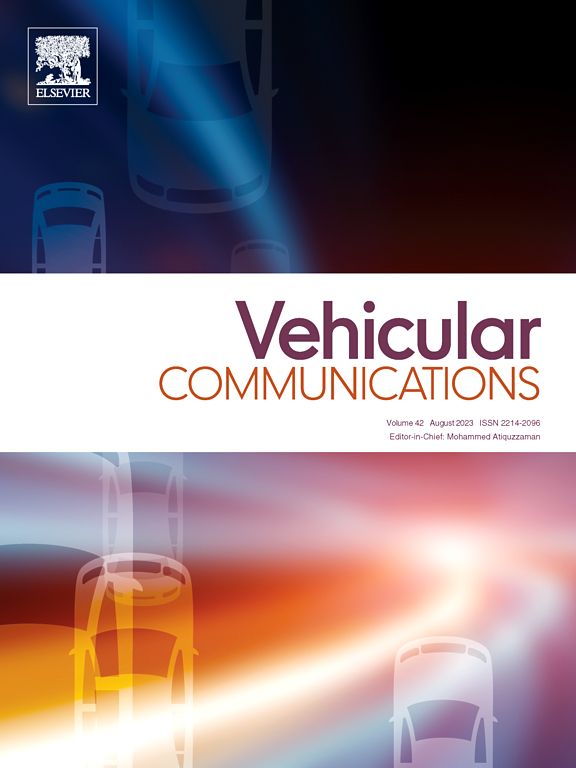Distributed Dynamic Consensus (DDC) protocol for multi-UAV 3D trajectory planning and resource allocation
IF 6.5
2区 计算机科学
Q1 TELECOMMUNICATIONS
引用次数: 0
Abstract
In a Multiple Unmanned Air Vehicle (m-UAV) system, employing a centralized communication approach poses many challenges such as communication range limitations, energy efficiency, latency, etc. due to limited UAV resources. On the other hand, a distributed consensus approach has the ability to overcome these limitations and possesses numerous advantages if appropriate coordination mechanism among the UAVs is employed. Therefore, in this paper, we investigate joint optimization of 3D trajectory and UAV resources using a distributed consensus approach. We assume that User Devices (UDs) compute a portion of the task locally and offload the remaining part to the nearby Mobile Edge Computing (MEC) based UAV. Considering UAV dynamics and environmental constraints, a Deep Deterministic Policy Gradient (DDPG) is presented based on Distributed Dynamic Consensus (DDC) approach that utilizes consensus theory for distributed computing. We classified DDC into three cases namely; Distributed Velocity Consensus (DVC), Distributed Error Consensus (DEC), and Distributed Dynamic Velocity Consensus (DDVC). The performance of all three cases based on cost percentage (cost is the sum of normalized time delay and normalized energy consumption) and observed that DEC achieves minimum cost i.e., 40.62 whereas DVC and DDVC settled at 48.18 and 44.06 respectively. We further investigate the performance of DEC in partially connected, moderately connected, and fully connected networks. With centralized and autonomous decision-making scenario as a benchmark, results show that the DEC in the partially connected scenario converges faster with a lower cost.
多无人机三维轨迹规划与资源分配的分布式动态共识协议
在多架无人机(m-UAV)系统中,由于无人机资源有限,采用集中式通信方式存在通信距离限制、能源效率、延迟等诸多挑战。另一方面,如果采用适当的无人机间协调机制,分布式共识方法能够克服这些局限性,并具有许多优点。因此,本文采用分布式共识方法研究了三维轨迹和无人机资源的联合优化问题。我们假设用户设备(UDs)在本地计算任务的一部分,并将其余部分卸载给附近基于移动边缘计算(MEC)的无人机。考虑无人机的动力学和环境约束,提出了一种基于分布式动态共识(DDC)的深度确定性策略梯度(DDPG)方法,该方法将共识理论应用于分布式计算。我们将DDC分为三种情况:分布式速度一致(DVC)、分布式误差一致(DEC)和分布式动态速度一致(DDVC)。基于成本百分比(成本为归一化时延和归一化能耗之和)对三种情况进行性能分析,发现DEC的成本最小,为40.62,而DVC和DDVC的成本分别为48.18和44.06。我们进一步研究了DEC在部分连接、中等连接和完全连接网络中的性能。以集中式自主决策场景为基准,结果表明,部分连接场景下的DEC收敛速度更快,成本更低。
本文章由计算机程序翻译,如有差异,请以英文原文为准。
求助全文
约1分钟内获得全文
求助全文
来源期刊

Vehicular Communications
Engineering-Electrical and Electronic Engineering
CiteScore
12.70
自引率
10.40%
发文量
88
审稿时长
62 days
期刊介绍:
Vehicular communications is a growing area of communications between vehicles and including roadside communication infrastructure. Advances in wireless communications are making possible sharing of information through real time communications between vehicles and infrastructure. This has led to applications to increase safety of vehicles and communication between passengers and the Internet. Standardization efforts on vehicular communication are also underway to make vehicular transportation safer, greener and easier.
The aim of the journal is to publish high quality peer–reviewed papers in the area of vehicular communications. The scope encompasses all types of communications involving vehicles, including vehicle–to–vehicle and vehicle–to–infrastructure. The scope includes (but not limited to) the following topics related to vehicular communications:
Vehicle to vehicle and vehicle to infrastructure communications
Channel modelling, modulating and coding
Congestion Control and scalability issues
Protocol design, testing and verification
Routing in vehicular networks
Security issues and countermeasures
Deployment and field testing
Reducing energy consumption and enhancing safety of vehicles
Wireless in–car networks
Data collection and dissemination methods
Mobility and handover issues
Safety and driver assistance applications
UAV
Underwater communications
Autonomous cooperative driving
Social networks
Internet of vehicles
Standardization of protocols.
 求助内容:
求助内容: 应助结果提醒方式:
应助结果提醒方式:


